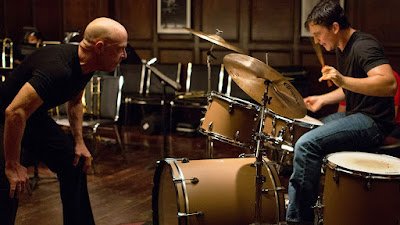 |
| Fig 1 - Lock, Stock and Two Smoking Barrels Poster |
Written and directed by the cor-blimey boat-race of British entertainment himself Guy Ritchie,
Lock Stock follows the story of a couple of cheeky lads tryina' get a bit of business done, y'know what I mean? When Eddy (Nick Moran) finds himself in debt to the fearsomely 'hard' Harry "The Hatchet" (P.H. Moriarty) at the climax of a back-door poker game, he calls upon the help of his friends "Bacon" (Jason Statham), "Soap" (Dexter Fletcher) and Tom (Jason Flemyng) to "sort out some dosh" before the week is up. Half a million pounds worth, to be precise. They decide to do this by stealing from
another group of trigger-happy nutters who've already gone and racked up a staggering loot of drugs and money from yet
another group of less-equipped stoner-types. Meanwhile, Big Chris (Vinnie Jones) is featured "doin' the rounds" as Harry's right-hand man on the streets, with his young son at his side to presumably get him involved in the criminal underworld as early as possible. Eventually, all of these mugs are brought together in a series of showdowns that intertwine their narrative threads and, wouldn't you know it, everything goes a bit pear-shaped along the way...
 |
| Fig 2 - Lock, Stock and Two Smoking Barrels - Soap, Bacon, Eddy & Tom |
If you can't already tell, I really struggle to take Guy Ritchie seriously as a filmmaker. Not to say that his films are
supposed to be taken seriously, I don't think that at all. But for all the effort that I'm sure went into making
Lock Stock, I just couldn't be further from my comfort zone watching it. What I didn't get with Ritchie's
Snatch was an over-arching feeling of boredom and disillusionment, which this film seriously suffers from (particularly as a contender of the Top 250). It obviously tries to put a British spin on the tried-and-tested stylings of Tarantino, but in such an incomprehensible way. I find myself so irritated by the cockney linguistics of the dialogue that I'm completely distracted from the plot. Not to mention the homophobic slurs spilling out of characters mouths faster than the barrage of expletives that came before. The editing is nowhere near as creative or interesting as
Snatch, which was a real disappointment. Hell, even the over-saturated yellows and browns that dominated it's palette were an eyesore. If it weren't for the soundtrack, I'd probably have nothing positive to say about this film.
Ritchie is a director known for emphasising the gritty street-wise nature of British culture, albeit during a period that is now utterly obsolete in it's anti-progressive mindset. As such,
Lock Stock is no exception and it's jingoistic undertones don't appeal to me in the slightest. Cups of tea and stately homes, card games down the pub. It's a wonder Dick Van Dyke doesn't show up for a ditty on the old Joana. Sure, Ritchie makes fun of the rhyming slang in a 'subtitles' bit in which a character tells a story about setting someone on fire with the 'proper English' written alongside, but it didn't matter. It's been done before in numerous iterations and overall, the film was awash with the most basic of techniques. In terms of comparative ingenuity,
Lock Stock makes
Snatch look like bloody
Pulp Fiction.
Although
Lock Stock obviously has a dedicated following and attempts to reach the heights of Tarantino's abilities, it simply never grabbed my attention. The convoluted plot, rough acting, rougher gags and generally unpleasant mood of the film made it frankly unwatchable in my eyes.
★★
Imagery
Fig. 1 Lock, Stock and Two Smoking Barrels Poster (1998) From: Lock, Stock and Two Smoking Barrels (1998) - Directed by: Guy Ritchie
https://ae01.alicdn.com/kf/HTB1pOslJVXXXXXAXXXXq6xXFXXXL/P0485-Lock-Stock-and-Two-Smoking-Barrels-Movie-Poster-Wall-Sticker-Art-Canvas-Printings-posters-24x36inch.jpg
Fig. 1 Lock, Stock and Two Smoking Barrels Screenshot (1998) From: Lock, Stock and Two Smoking Barrels (1998) - Directed by: Guy Ritchie
https://i2.wp.com/www.thecinemaholic.com/wp-content/uploads/2016/07/Lock-Stock-and-Two-Smoking-Barrels-1998.jpg?fit=1024%2C555&ssl=1














